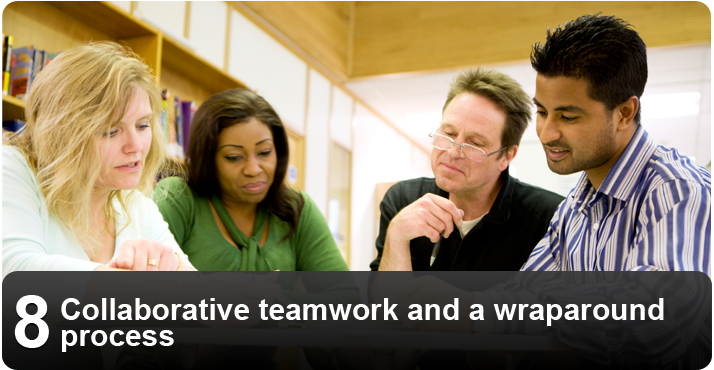|
Table of Contents
|

“Never doubt that a small group of thoughtful committed people can change the world. Indeed it is the only thing that ever has.” – Margaret Mead Since students’ problem behaviour pervades most areas of their home and school lives, a team approach is essential. The learning team
|
 |
For more information, see Alberta Education’s Individualized Program Planning (2005) available at https://education.alberta.ca/media/384992/indidivualized-program-planning-2006.pdf. |
Knowledgeable and skilled staff
School staff who work with students with behaviour disabilities need to:
- have knowledge about and experience with typically used and successful behavioural and cognitive strategies
- have ongoing access to learning opportunities, resources and classroom support that could help them meet these students’ behavioural needs
- be able to identify and implement positive behavioural interventions and then use data to evaluate the effectiveness of these interventions and make ongoing programming adjustments as required
- be knowledgeable about behaviours associated with particular disabilities such as AD/HD, autism or FASD
- have the skills required to prevent problem behaviours and respond appropriately when acting out behaviours occur.
Administrative support
School administrators need to understand and actively support the learning teams that work with individual students with behaviour disabilities. Understanding the challenges the team is dealing with will help administrators make informed decisions about
- resource allocation
- applying school policies
- strategies to support staff capacity building.
Family involvement
Students’ achievement, attitudes and behaviour all improve when parents and other family members are involved with the school. Working in partnership, the adults in a student’s life can “wrap around” a student to develop effective programming, interventions and supports.
Parents need to know specifically what behaviour is acceptable in the school and classroom. School staff need to work collaboratively with and talk to parents about strategies for dealing with inappropriate behaviours.
Have parents participate in the IPP development and review process. In addition to addressing academic and social needs, the IPP and day–to–day programming should recognize the student’s unique cultural and family needs.
Wraparound process
The wraparound approach to services for students with behaviour disabilities involves a family-centred philosophy of care that links naturally with positive behaviour support systems. This team approach places the student and the significant adults in his or her life at the centre of the process. The adults involved are usually the parents but in some cases they include another relative or a friend or support person.
The team members serve as resource people who can help school staff positively influence behaviours that compromise the student’s safety and learning. The team members work together to set the student up for success. For example, if a student loves to work at a local garage and fix cars, the team may work with an employer to provide extra time working on cars as a reward for maintaining a good school attendance record.
Many students with intensive behavioural needs may be involved with a number of community agencies or service providers. The wraparound process encourages all services to work together intentionally and collaboratively.
Onsite community partners
A team approach to providing a school-wide support system for students works best when it is onsite, multidisciplinary and multi-level. Members of an onsite support team could include, but are not limited to:
- public health and psychiatric nurses
- dietitian
- social worker/mental health therapist
- youth worker/family liaison worker
- community police resource officer.
Having a community of caring adults located right in the school on a regularly-scheduled basis (e.g., several hours each week or half-a-day a month) provides rich opportunities for:
- building positive relationships
- teaching social skills and problem solving
- providing intervention and support on an as-needed basis.
With these kinds of supports in place, students have more opportunities to gain the knowledge and skills to choose healthy behaviours, to make better life choices and, ultimately, to respond to life’s changes and challenges with resiliency and emotional maturity.
This collaborative “all for one” approach—in which partners work together to support one school, one classroom and one individual student, will help create a stable, caring environment for learning and teaching.
 |
For more information on Alberta's Approach to Collaborative Practices based on wraparound principles visit: https://education.alberta.ca/collaborating-to-support-students/collaborative-practices/ |
